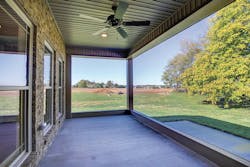Frustrated with the methods and products out there for screening a porch, SCREENEZE inventor Ray Bass devised his own self-stretching system designed to simplify installing screens. We got to see it in action at the 2018 Remodeling Show.
The SCREENEZE system consists of an aluminum base and a vinyl cap that snap together, securing the screen fabric and eliminating the need for spline or staples. The system keeps the screen so tight that even 140mph winds will not blow it out of place, according to tests recently conducted by the company.The system isn’t structural, so the aluminum base must be installed on a timber built porch, with either a corner or flush mount. SCREENEZE can be installed inside, outside, or in the center of a porch frame.
“Because the system is self-stretching, metal screens, pet screens, and some solar screens don’t work well,” says Lauren Hamby, a SCREENEZE sales and marketing rep. “It comes down to the give of the material and the thickness, but fabric screens work best.”
The SCREENEZE system consists of an aluminum base and a vinyl cap that snap together, securing the screen fabric and eliminating the need for spline or staples.
With the aluminum bases screwed into all sides of the porch frame, the screen is placed over the base channel, leaving about 2 inches of excess fabric on each side. Because the system is self-tightening, installers should install the top cap first and let the fabric drape over the bottom channel, positioning the screen so that it is square and wrinkle-free on either side of the channel.
Beginning with the top, the vinyl caps are tapped into place with a rubber mallet on top of the aluminum base and screen fabric. Once the system is assembled, the excess screen fabric can be cut off with a utility knife.
If the fabric isn’t straight or if puckering occurs, fixing it is as easy as snapping out the cap—a flat-head screwdriver works well—and readjusting, say company officials. The same goes for replacing the screen: Pop off the cap and place the new screen, without removing the entire system.
Thanks to its self-stretching quality, SCREENEZE can be used on openings as large as 150 square feet without the help of posts. “Most other systems can only go up to 40 square feet,” says Hamby. “The base and cap secure the fabric and keep it tighter than when spline is used. Once a spline system gets over 40 square feet, the screen starts to sag.”
SCREENEZE is available in four colors (white, sand, clay, and bronze) and in 8- and 12-foot lengths, which can be easily cut and combined to fit custom opening sizes. The system comes with a 10-year warranty.

